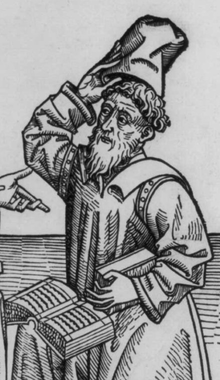Borzūya
| Borzūya | |
|---|---|
 Artwork of Borzūya. | |
| Born |
5th century - 6th century Abarshahr or Merv[1] |
| Died |
6th century Sassanid Iran |
| Education | Possibly the Academy of Gondishapur |
| Known for | Translating many books into Pahlavi |
|
Medical career | |
| Profession | Physician |
Borzuya (or Burzōē or Burzōy) was a Persian physician in the late Sassanid era, at the time of Khosrau I. He translated the Indian Panchatantra from Sanskrit into Pahlavi. But both his translation and the original Sanskrit version he worked from are lost. Before their loss, however, his Pahlavi version was translated into Arabic by Ibn al-Muqaffa under the title of Kalila and Dimna or The Fables of Bidpai and became the greatest prose of Classical Arabic. The book contains fables in which animals interact in complex ways to convey teachings to princes in policy.
There is considerable discussion whether Borzūya is the same as Bozorgmehr.[2] While sources indicate they are different people, the word "Borzūya" can sometimes be a shortened form of Bozorgmehr.[3]
See also
- Bozorgmehr
- Academy of Gundishapur
- Sassanid Empire
- Tribe of Borzai
References
- ↑ http://www.iranicaonline.org/articles/borzuya-also-burzoe-a-physician-of-the-time-of-kosrow-i-
- ↑ François de Blois (1990), Burzōy's voyage to India and the origin of the book of Kalīlah wa Dimnah, Routledge, ISBN 978-0-947593-06-3
- ↑ Djalal Khaleghi-Motlagh, "BORZŪYA" in Encyclopaedia Iranica. Oneline link accessed in December 2010: BORZŪYA.